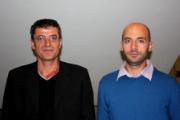
“Many people are being led to believe that the conflict in Palestine is religious, but it is clearly political,” maintains Mr Iyas Ashour. Visiting Rhodes last week along with fellow activist Dr Anis Daraghma, the two provided a decisive and moving account of the conditions in what they call “the military state of Israel.”
Hosted by the History Department and the Rhodes University Palestinian Solidarity Forum (RUPSF), “Snaps of Palestinian political discourse: a photographic history of the Palestinians in the 20th century” focussed around a series of photographs, starting with sepia snaps of the Ottoman empire, which governed the Middle East and North Africa including Palestine for 500 years.
Discussing the myths and misconceptions around Palestine, Dr Daraghma said that: “Palestine is a country without people for people without country.” For Palestinians, the geographical area has shrunk to almost nothing while the geography of Israel amounts to 120% of Palestine.
“The concept of Palestinian territories is not popular among Palestinians and their solidarity groups. Instead Palestinians, Muslims, Arabs, and the solidarity groups of Palestine uses the concept of historic Palestine,” he said.
Now, the majority (about 55%) of Palestinians are displaced to Jordan, Lebanon, Syria and the diaspora while 45% are living under military occupation in the Gaza Strip and West Bank and some in Israel. “A total of 76 massacres have taken place in Palestine, 70 of them in 1948 and the other six after that date,” he says. “A total of 76 massacres have taken place in Palestine, 70 of them in 1948 and the other six after that date,” he says.
People are being deported from the refugee camps or evacuated from their homes or property virtually every day in East Jerusalem, Gaza and the West Bank. Conditions are at their worst in Gaza the biggest concentration camp and the most densely populated area in the world with 1.6 million people packed into a mere 360 square kilometres. ”People’s homes are demolished and, in Hebron, “crazy radicals are taking over people’s houses. If you defy them you are imprisoned.”
Mr Ashour recited a poem by Palestine’s national poet, Mahmoud Darwish (1941-2008). “As you liberate yourself with metaphors, think of those who have lost their right to speak. I wish I were a candle in the darkness...” Telling the story of the millions of refugees living in tents for more than 60 years, he says: “They are awaiting an uncertain fate, with inadequate shelter, food, water or medical treatment.”
Dr Daraghma grew up on the West Bank, which is one of the highest conflict areas in the world. He moved to Cape Town to write his PhD at the University of Cape Town and was appointed as the director of the Palestine Museum in Cape Town in January 2011. He is making great strides in “educating the public about the diversity, heterogeneity and randomness of Palestine political discourse, rather than victimisation”.
Dr Daraghma mentions how the struggle for freedom has gained sway via social networks with many messages of solidarity posted every day. One particular activist, Hana, embarked upon a hunger strike while in prison for over 40 days. The strike, in which 1200 Palestinian prisoners participated, ended on 14 May.
Photo and story by Anna-Karien Otto
Photo: From l-r: Dr Anis Daraghma and Mr Iyas Ashour.
